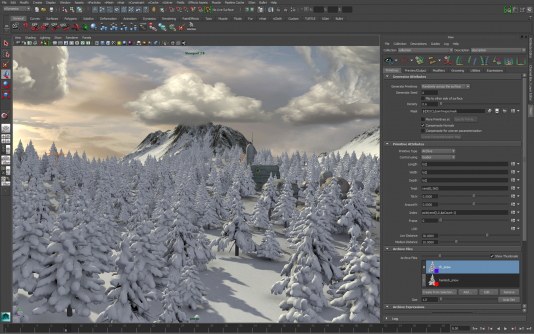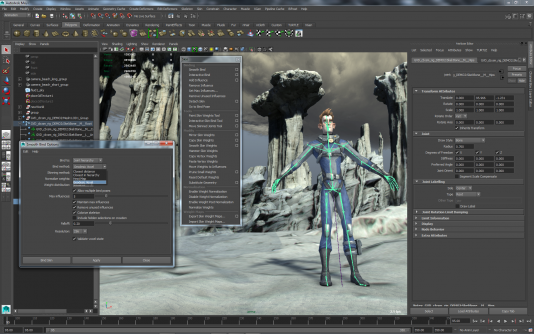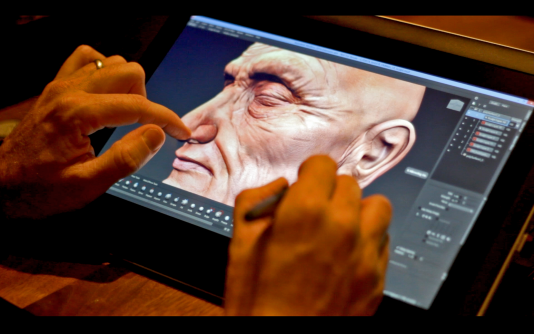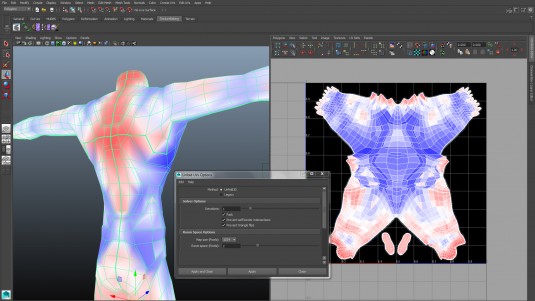The addition of Bifrost to Maya is a bridge to the future for users who will miss Softimage’s extensibility.
Autodesk today announces its 2015 update to its Entertainment Creation Suites, with an emphasis on improving everyday tasks. The release is a milestone for two reasons:
- Maya LT joins the M&E product line — but not the suites — for the first time;
- Softimage is updated for the last time, as Autodesk starts the clock to the product’s end of life.
We reported on the Softimage transition two weeks ago; see the list of related articles below. Maya LT has become Autodesk’s answer to “the ‘next big thing’ that never wasn’t a big thing,” according to Autodesk VP Maurice Patel. Mobile gaming started as an indie phenomenon hidden in plain sight while major game publishers focused on console games, but in recent years has come into its own. As we have reported in the past, Autodesk is retooling Maya LT as a content development platform specifically for mobile gaming, and has been releasing updates at an aggressive pace since its launch August 2013.

This year, Autodesk will offer two Suites: Standard and Ultimate. The Standard edition includes either Autodesk 3ds Max 2015 or Autodesk Maya 2015 3D modeling, and rendering software, with Autodesk Mudbox 2015 digital sculpting and painting software, and Autodesk MotionBuilder 2015 real-time virtual production and character animation software. With the Ultimate edition, artists have access to every product in the Standard edition together with both Maya and 3ds Max, as well as Autodesk Softimage 2015 visual effects and animation software.
With each annual edition Autodesk brings more interoperability to the products in each suite. New capabilities in this release include:
- The ability to exchange Ptex and multi-tile UV textures between Maya and Mudbox helps facilitate an iterative round-trip workflow between Mudbox and Maya;
- Enhanced image plane matching between Maya and Mudbox allows artists to use the same reference image without having to readjust the image to match;
- Export Blend Shapes with multiple targets or Blend Shapes from Maya into Mudbox for sculpting, and then merge them back into the original Maya scene;
- Import MotionBuilder character animations created in Softimage in a single step and export CrowdFX simulations from Softimage to Maya for inclusion with scene elements in one click.
Greater extensibility in Maya
Softimage is noted for its customization capabilities, and in particular ICE (Interactive Creation Environment). What Autodesk is taking away with Softimage, it is giving back in Maya, with the introduction of the Bifrost procedural effects platform. Bifrost is a technology acquired in 2012 when Autodesk bought technology from Exotic Matter, a Vancouver-based developer. Some of the EM team joined Autodesk, and started working on what is now known as Bifrost. (We note “Bifrost” is a bridge between realms in Norse mythology, and seems to be one in content development between Softimage and Maya.)

This first release of Bifrost offers new features for simulating and rendering photorealistic liquids, but the plan is for a broader range of capabilities overtime. Other significant enhancements in Maya 2015:
- XGen Arbitrary Primitive Generator enables artists to create and groom hair, fur, and feathers on characters, and populate large landscapes with grass, foliage, trees, rocks, and debris trails. Artists can use XGen to control the appearance and behavior of primitives by setting attributes, painting maps, creating expressions, or using a set of interactive grooming tools; long hair can be controlled by creating guide hairs, which can be simulated using the Maya nHair toolset. XGen has been used by Walt Disney Animation Studios in the animated films Tangled, and Bolt, and by Pixar Animation Studios in Toy Story 3;
- Geodesic Voxel Binding, a new skinning method for binding geometry to joint skeletons often with only a few clicks;
- ShaderFX provides games artists and programmers the ability to create HLSL, GLSL, and CgFX viewport shaders with the ShaderFX real-time visual shader editor. Shader networks are created by connecting different nodes together using an click-drag workflow;
- OpenSubdiv libraries integration allows artists working on both film and games productions to represent subdivision surfaces in Maya using the OpenSubdiv libraries open-sourced by Pixar. The technology allows users to take advantage of parallel CPU and GPU architectures for faster draw performance;
- Enhanced polygon modeling to more quickly retopologize high-resolution meshes for cleaner deformations and better performance.
3ds Max for design and art
3ds Max lives in two worlds: it is popular with 3D content creators in media and entertainment, but also has a strong following in architecture and product development for design visualization . Key new and enhanced features in 3ds Max 2015 include:
- Point cloud support for reality capture workflow when used in tandem with other Autodesk products such as ReCap, AutoCAD, Revit, and Inventor;
- Python scripting, which will allow 3ds Max users to integrate into Python-based content management pipelines;
- ActiveShade rendering enhancements, adding support for Mental Ray and improving use with Iray. With ActiveShade, artists and designers can see the effects of changing lighting or materials interactively, helping them refine their work faster;
- Accelerated viewport performance, including a number of improvements to accelerate navigation, selection, and viewport texture baking. In addition, anti-aliasing can now be enabled with minimal impact on performance;
- ShaderFX provides game artists and programmers with the ability to create advanced HLSL viewport shaders with the ShaderFX real-time visual shader editor;
- Enhancements to the scene management tools, including new nested layer functionality within Scene Explorers to help artists and designers better organize data.

Last Softimage updates
Even though Autodesk has announced the end-of-life sequence for Softimage, the 2015 edition includes new features. This version will also ship in next year’s Ultimate Suites before being discontinued. New features include:
- Alembic caching allows artists to read and write the Alembic open computer graphics interchange framework format. Alembic distills complex animated and simulated data into application-independent baked geometry;
- Various tweaks to improve ICE speed, performance and usability;
- Access to previously unexposed Mental Ray functionality, including Light Importance Sampling, Native Image Based Lighting, and progressive rendering.
- Animatable weight maps in Syflex cloth.
MotionBuilder adds Kinect support
Software for motion capture, MotionBuilder supports both consumer-level and professional motion capture devices. Topping the list of new features is support for Microsoft Kinect. Other new or improved features:
- Advanced camera options to recreate aspects of real-world cinematography, which Autodesk says will allow directors to stay true to creative intent. Animatable Depth of Field helps artists mimic a change in aperture in the real camera, affecting the range of objects in view that are in focus, while a Follow Focus option enables artists to lock a camera’s focus on an particular object in the scene, keeping it in focus as its distance to the camera changes;
- A Moves content library ships with MotionBuilder 2015, providing an additional 100 animations in Autodesk FBX asset exchange format. Artists can use these animations to combine, blend, and layer to block out or previsualize scenes or use as a starting point for further refinement. Moves have been selected to offer coverage for frequently encountered scenarios, with walking, running, jumping, crawling, falling, fighting, and idling categories, as well as those that involve furniture or weapons;
- Flexible marker assignment for improved captured data when motion is mapped to a CG character not proportionally similar to the original actor.
Mudbox retopologizing improvements
Mudbox offers tools for digital sculpture and painting of 3D objects, and is often used in conjunction with a primary animation platform. New or improved features include:
- Streamlined mesh refinement for retopologizing (editing basic mesh geometry);
- New Sculpt Layer and Paint Layer groups for organizing and identifying particular layers in complex scenes;
- Improved interoperability with Maya 2015;
- An enhanced texture export and updating workflow;
- New caliper tool and support for Intel HD Graphics 4000 on compatible Windows 8 operating system hybrid tablet/PCs.

Maya LT for indie game development
Autodesk first introduced Maya LT in August 2013, and has updated it twice since. Maya LT is not included in any suites bundle. The release announced today will introduce more features, including:
- Cloud integration, allowing artists to browse, open, modify and save Dropbox or Autodesk 360 files to the cloud directly through the Maya LT interface. The integration also means Maya LT users will have access to files created in Autodesk’s 123D Catch and 123D Creature apps;
- Unfold 3D, a feature that facilitates creation of UV maps from 3D models (“UV” refers to the 2D axes of the texture modules)
- Substance Material Integration allows users to apply materials created in the Allegorithmic Substance Designer procedural texture creation tool to 3D models.

Suite availability
Autodesk says product release will dates vary by country; the rollout will start today and continue for several weeks. The products and suites are available in two configurations: as a perpetual license or desktop subscription.
Related
Autodesk to discontinue Softimage
Competitors leap to replace Softimage
Autodesk modified Softimage end-of-life terms





